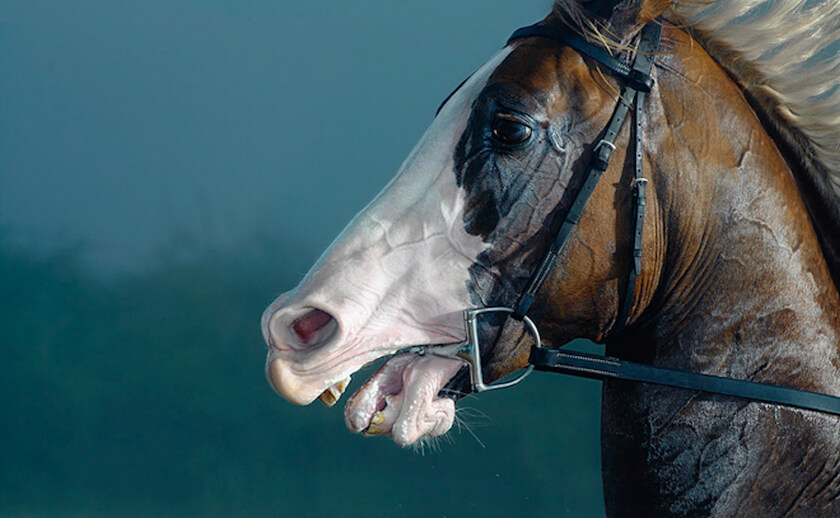Another case involving ADM Alliance Nutrition horse feed is suspected in damaging the health of at least eleven horses after feed tested positive for monensin contamination — this time in Georgia. Following the tragedy of the deaths of three horses in South Carolina earlier this month from ADM horse feed, Roslyn Johnson, an eventer from Grantville, Georgia, panicked because multiple horses in her barn ate the same brand of feed from ADM, including her own Cornichon, a 16-year-old Thoroughbred gelding named Beau.
Johnson immediately took samples from three feed bins in her barn containing ADM Alliance Nutrition Patriot Performance Horse Feed 12-10 (lot #GA35614) and shipped them to the Michigan State University (MSU) Diagnostic Center for Population and Animal Health for testing. Johnson’s worst fears were confirmed — monensin was detected in two of the three samples.
What is so terrifying for horse owners is how deadly monensin is: It takes just a half a gram of monensin to kill a horse. For example, in an average 1000-pound horse, a dose as small as 0.5-1.5 grams (0.017- 0.052 ounces) can be fatal if ingested. The LD50 value (the dose required to kill 50 percent of a population of test animals) in a horse is about 2.0 milligrams of monensin per kilogram of body weight. In fact, monensin is as deadly as cyanide: The LD50 for cyanide ingestion is 50-200 milligrams, or 1.0-3.0 mg per kilogram of body weight. So, any time a horse is exposed to monensin, it’s a problem.
Unfortunately, MSU is only able to identify whether or not monensin is present in the feed and cannot determine the level of toxicity. However, there is no known safe level of exposure to monensin for horses. So, Roslyn’s samples went to UC Davis for quantitative testing (a test that determines the amount of a substance per unit volume or unit weight), but that testing takes several days, and the results are still pending.
After learning that the feed tested positive for monensin, Johnson took Beau to the University of Georgia College of Veterinary Medicine for cardiac evaluation. Although Beau did not show any immediate clinical signs of illness or display abnormal behavior, a disturbing anomaly appeared in Beau’s blood work, which showed elevated levels of troponin, a naturally occurring enzyme in the muscles of the heart.
The normal troponin level in a healthy horse is less than 0.03 nanogram/milliliter (ng/mL). Beau’s test results showed a troponin level of 0.371 ng/mL. The official diagnosis from the University was myocarditis: inflammation of the heart muscle.
Due to the apparent exposure to monensin, it was recommended that the serum troponine concentration be repeated in three to four days. Three days later, another blood sample revealed Beau’s troponin levels doubled to .61 ng/mL indicating a very serious condition. Another cardiac evaluation in two weeks will reveal additional information.
A dozen other horses at the boarding stable also ate the allegedly contaminated feed. All but two have elevated troponin levels that range from .04 ng/mL to .97 ng/mL. Sources confirmed at least seven with elevated troponin levels. Two measured above 0.9 ng/mL — dangerously high troponin levels.
The Georgia Department of Agriculture visited the farm on January 21 and collected samples of feed there, as well as from unopened bags with matching lot numbers at the store where the feed was purchased. The store owner has since removed the feedbags with a matching lot number (#GA35614) from the shelves in his store.
An FDA spokesperson confirmed that they are looking into the situation but said they cannot comment on ongoing investigations. However, an FDA spokesperson said, “there is no acceptable amount of monensin allowed in equine feed – it is not approved.”
An ADM representative traveled to the farm requesting permission to test feed; unfortunately, Johnson was on her way to University of Georgia College of Veterinary Medicine with Beau and did not feel comfortable granting permission for samples to be taken in her absence.
When asked why ADM has not taken action, now that there are allegations of monensin tied to two different types of ADM equine feed out of the same mill in Cordele, Georgia, a company spokesperson responded:
“We have reached out to the customers who have contacted us with concerns and are reviewing test results and any additional information they’ve provided. We have also taken feed samples from their dealer and have sent those to a third-party for additional testing.”
In a prepared statement, ADM claims that that samples from the South Carolina case had been sent to a third-party laboratory for testing:
“Every sample tested negative for monensin at the detection limits for the respective tests. Any trace amounts of monensin in the feed present below the detection limits of these tests would not be toxic to horses. We have seen no evidence that implicates our horse feed in these animals’ deaths.”
Read more about it:
Monensin poisoning in horses – an international incident
Cross-contamination of non-target feedingstuffs by monensin
SOURCE: http://eventingnation.com/home/contaminated-horse-feed-causes-panic-in-georgia/


Comment (1) Write a comment